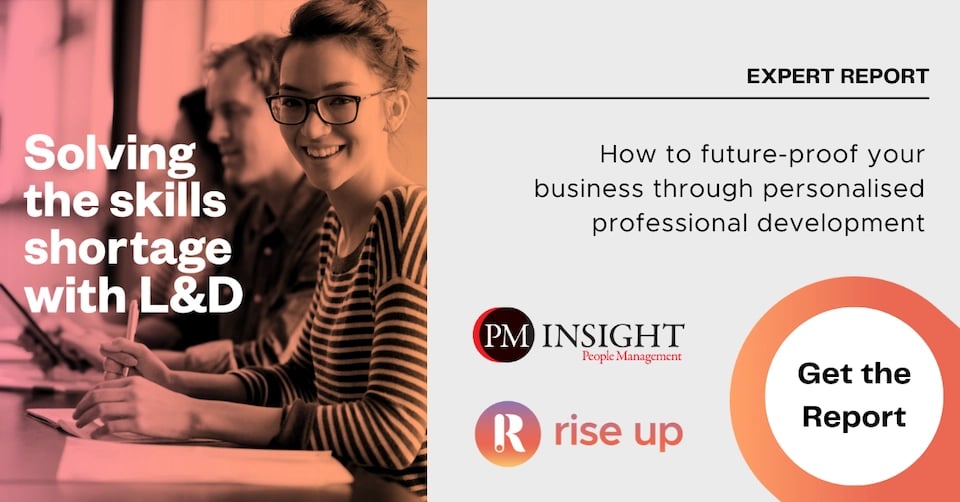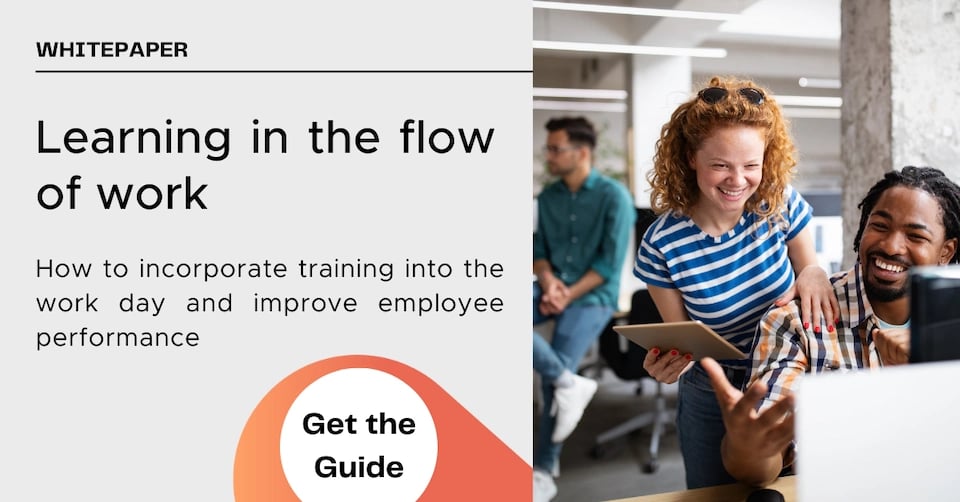8 Minutes of reading
Solving the skills shortage with L&D - Expert Report with People Management Magazine
Rise Up teamed up with the industry magazine People Management to produce a report on Solving the skills shortage with L&D. The whitepaper looks at the current employee landscape and outlines the very important role Learning and Development and HR teams can play in addressing the skills crisis. This article will outline a preview of our insights. You can download the full guide here.
The current employee crisis
The UK is suffering from an acute shortage of skills. When the Chartered Institute of Personnel and Development (CIPD) conducted its Spring 2022 Labour Market Outlook survey, it found that 45% of employers are struggling to recruit the skills they need, reporting a high number of hard-to-fill vacancies.
Factors that have compounded the historical skill shortage include:
- Brexit
- Covid-19
- The Great Resignation era
- The impact of digital transformation
Employers in every sector of the UK economy suffer from a lack of skills, many of which are business-critical. Those shortages are felt throughout organizations, from entry-level to senior leadership roles. Digital skills are in short supply, but there is also strong demand for softer skills, such as problem-solving, resilience, leadership, and the ability to deal with change and uncertainty.
Recruitment and retention are a massive problem as employers find it increasingly difficult to source the right talent and keep hold of them.
What can L&D professionals do to combat the skills gap in their organization?
Begin with a skills audit
Do your homework. Conduct a skills gap analysis to inform you of where the holes are and how big those holes are.
What skills are in short supply - requiring employees to be upskilled and reskilled?
What skills does the business need today
What skills will it need tomorrow?
What are the business objectives, and is the L&D strategy aligned with them?
Take the pulse of the organization as well. Consider what the workforce says about skills and what your HR and employee survey data tell you. Talk to line managers to get their views. This is about combining workforce planning with horizon scanning.
Although learning departments need to keep on top of learning needs and objectives, they are no longer the gatekeepers of learning. Employees should be engaged with their own learning needs, seeking out learning themselves. Of course, this is only possible if they have the right learning platforms and resources and the organizational culture supports it.
You can’t just rely on salaries to retain employees
When there’s a skills crisis, the temptation is to keep firefighting – putting up pay to attract staff. But that only ever works as a short-term solution. And salary rates have been going up so rapidly in some sectors that further increases are not sustainable. So, what else can employers do? Give employees something that they want: skills development.
People want to learn new skills, and they want to be productive and fulfilled at work and to know that their career is progressing. Investing in upskilling and reskilling is the perfect solution – it ensures businesses have the skills they need while also helping with recruitment and retention at the same time.
Hybrid, blended learning – the future of learning is here
Consider how the workforce wants to learn. The shift to hybrid working prompted a seachange in how we all learn. Those barriers to digital learning came down very quickly when Covid-19 struck, and it was digital learning or nothing. Now learners and trainers have benefited from the convenience and effectiveness of digital learning, why would anyone go back to the old classroom training model with a bit of compliance e-learning thrown in? People have embraced blended learning and they want choice. They want to be able to learn on the move or at least remotely, which means it needs to be accessible via mobile. They want to learn at the point of need. And they want the option to learn in flexible bite-sized chunks.
Of course, sometimes face-to-face learning is still the better option, but it’s no longer the only option. It’s about choice – hybrid learning in a hybrid world. L&D needs to understand how to combine face-to-face with digital modalities to ensure all employees have positive, effective learning journeys. When this happens, and learning happens in the flow of work, it is so much easier to achieve the all-important learning culture.
To help you understand what “learning in the flow of work” is, what benefits it can offer and how to implement it within your organization, we’ve produced a handy whitepaper.
Personalized learning experiences to uplift skills
Learning experience platforms enable really targeted, engaging training. Learners want interactive, immersive learning experiences, so consider solutions such as AI, virtual reality, and augmented reality.
Give people access to the learning that will help them do their jobs better and move their skills and careers forward. They don’t want to sit through an hour of learning for just five minutes to be relevant and useful. It’s better to give them the five minutes and make those really count.
Domino’s Pizza and their blended learning story
When learning works, it can greatly impact the culture of an organization, like Rise Up customer Domino’s. The restaurant chain came to Rise Up with several key challenges that needed addressing:
- ensuring everyone had the same access to training
- developing a performance-driven culture
- reducing the administrative burden
- engaging and managing a young audience of learners
- organizing face-to-face sessions.
The solution? We helped set up a blended learning course that combined face-to-face with e-learning. The learner experience and collaboration improved significantly and led to an increased employee retention rate of 42%! Improvements to the program that led to this include training being rolled out at twice the speed and mobile-optimized e-learning so employees can learn on the go and when it suits them.
Read the full success story here.
Want to learn more about mitigating the skill crisis risk?
Download the full guide here.





